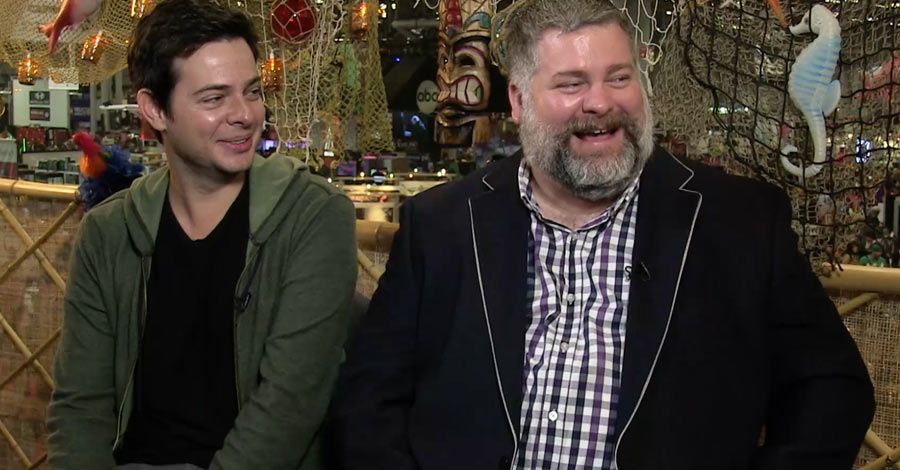Dreamworks Animation's "How to Train Your Dragon" wasn't just a hit animated film, it was the beginning of a bonafide franchise. With two critically-acclaimed and commercially successful movies and the "Dragons: Race to the Edge" animated series on Netflix, the story of Hiccup and Toothless is only getting bigger and better. In fact, at New York Comic Con Dark Horse Comics announced a series of "How to Train Your Dragons" original graphic novels co-written by "HTTYD" writer/director Dean DeBlois and "Race to the Edge" writer Richard Hamilton.
RELATED: "How To Train Your Dragon" OGNs Come to Dark Horse
During the convention, DeBloi and Hamilton sat down with CBR TV's Jonah Weiland to discuss why comics are the perfect avenue to fill in events between the animated movies, the transitions they've had to make as storytellers and some hints about what to expect from 2018's "How to Train Your Dragon 3."
In part one, "How to Train Your Dragon" director DeBlois explains why the animated franchise is making the jump to the printed page at Dark Horse as well as what problems and possibilities it opens up. His co-writer on the OGNs, Richard Hamilton, explains what fans can expect to see in each book in terms of new characters (yes, that means dragons) and how it all syncs up with the movies.
On expanding the world of "How to Train Your Dragon" with in-continuity graphic novels:
Dean DeBlois: It's a great opportunity because with graphic novels you can go inside the characters' heads, you can explore this sort of expanding world of Hiccup's kingdom. There's [the Isle of] Berk and then the surrounding islands, a lot of them haven't been discovered yet, home to dragons, home to different tribes. There's a great world to delve into and I think the graphic novels give us a chance to meet some new characters, and new dragons, and kind of develop and explore new relationships both contentious and friendly.
On what it's like making the transition from writing "Dragons" in animation to comic books:
Richard Hamilton: It's a real exercise in economy and really just boiling things down to what are the key images you need for the plot really to sell an emotion. And we're very lucky with the art on the books so we have a lot of help there. But it's also really trying to live in the fact these are comics, we're not just trying to make another movie or another TV show; we're trying to use things like thought balloons, really leaning on the art to sell the acting of the dragons. Dragons don't talk, so how do we boil that down to 2D artwork and how does the lettering support that, how does the coloring support that. It's really a lot of fun trying to sort of reinvent the storytelling.
Baruchel, DeBlois Talk Hockey, Childhood Passions and "How to Train Your Dragon 2"
On why they wanted to expand the world with comics given the successful film franchise and Netflix animated series:
DeBlois: I think there's two things. We definitely have a growing and very rabid, fervent fanbase. They constantly want feeding; they want more material and graphic novels are a way of kind of feeding that in a different medium that allows for us to be creative in different ways. And also, both Richard and I grew up on comic books and I think we both had aspirations to want to be in the comic book industry. It was my sole goal to be a comic book illustrator in the beginning and I only discovered animation because I couldn't find a course in comic book illustration. And I think the writing naturally developed with my interest in telling stories; Richard's the same way. It's deep-seeded love, so it's both wonderful for us personally to get into it, but also to constantly put more out there for the fans who are interested in what we're doing.
In the second half of their conversation, DeBlois and Hamilton share the comic books that left the greatest impact on them creatively, future comic aspirations beyond "Dragons" and the major differences between telling stories in the animated medium and in comic books. While the third "Dragons" film is still more than two and a half years away, the director offers up a tease about what's next for Hiccup and Toothless.
On the storytelling differences between comic books and animation:
DeBlois: Certainly most of what I learned about staging and composition came from comic books first and foremost. And then I found as I started studying film those that were very graphically invested like Ridley Scott, that that was the bridge because Ridley puts a lot of emphasis on composition and staging. And he draws a lot of his own storyboards. So there's a definite connection 'cause he's a huge fan of Moebius and so there's a comics influence that kind of found its way into film and I naturally gravitated toward that.

